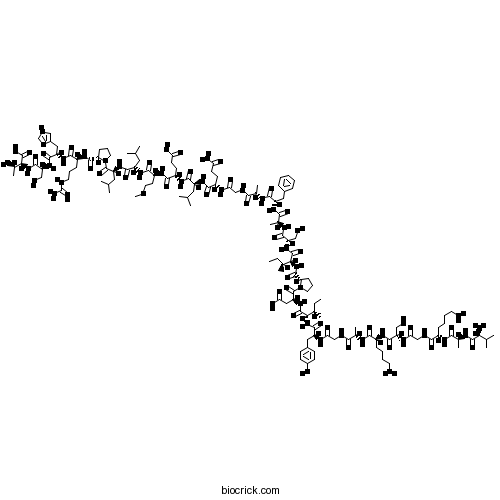C3bot (154-182)Neurotrophic fragment of clostridial C3 protein CAS# 1246280-79-4 |

- FLAG tag Peptide
Catalog No.:BCC2562
CAS No.:98849-88-8
Quality Control & MSDS
3D structure
Package In Stock
Number of papers citing our products

| Cas No. | 1246280-79-4 | SDF | Download SDF |
| PubChem ID | 90488913 | Appearance | Powder |
| Formula | C137H221N37O40S | M.Wt | 3058.54 |
| Type of Compound | N/A | Storage | Desiccate at -20°C |
| Solubility | Soluble to 5 mg/ml in water | ||
| Sequence | VAKGSKAGYIDPISAFAGQLEMLLPRHST | ||
| SMILES | CCC(C)C(C(=O)NC(CO)C(=O)NC(C)C(=O)NC(CC1=CC=CC=C1)C(=O)NC(C)C(=O)NCC(=O)NC(CCC(=O)N)C(=O)NC(CC(C)C)C(=O)NC(CCC(=O)O)C(=O)NC(CCSC)C(=O)NC(CC(C)C)C(=O)NC(CC(C)C)C(=O)N2CCCC2C(=O)NC(CCCNC(=N)N)C(=O)NC(CC3=CNC=N3)C(=O)NC(CO)C(=O)NC(C(C)O)C(=O)O)NC(=O)C4CCCN4C(=O)C(CC(=O)O)NC(=O)C(C(C)CC)NC(=O)C(CC5=CC=C(C=C5)O)NC(=O)CNC(=O)C(C)NC(=O)C(CCCCN)NC(=O)C(CO)NC(=O)CNC(=O)C(CCCCN)NC(=O)C(C)NC(=O)C(C(C)C)N | ||
| Standard InChIKey | COZZQWVNMFWMBN-QMBBDSMRSA-N | ||
| Standard InChI | InChI=1S/C137H221N37O40S/c1-19-72(11)108(170-125(202)91(57-80-38-40-82(179)41-39-80)155-103(182)62-147-111(188)74(13)150-116(193)84(34-25-27-48-139)158-127(204)96(64-175)156-104(183)63-148-115(192)83(33-24-26-47-138)157-113(190)77(16)153-131(208)107(141)71(9)10)132(209)167-95(59-106(186)187)135(212)174-51-30-37-100(174)130(207)171-109(73(12)20-2)133(210)169-97(65-176)126(203)152-76(15)114(191)162-92(56-79-31-22-21-23-32-79)121(198)151-75(14)112(189)146-61-102(181)154-86(42-44-101(140)180)118(195)163-89(53-68(3)4)122(199)159-87(43-45-105(184)185)119(196)160-88(46-52-215-18)120(197)164-90(54-69(5)6)123(200)166-94(55-70(7)8)134(211)173-50-29-36-99(173)129(206)161-85(35-28-49-145-137(142)143)117(194)165-93(58-81-60-144-67-149-81)124(201)168-98(66-177)128(205)172-110(78(17)178)136(213)214/h21-23,31-32,38-41,60,67-78,83-100,107-110,175-179H,19-20,24-30,33-37,42-59,61-66,138-139,141H2,1-18H3,(H2,140,180)(H,144,149)(H,146,189)(H,147,188)(H,148,192)(H,150,193)(H,151,198)(H,152,203)(H,153,208)(H,154,181)(H,155,182)(H,156,183)(H,157,190)(H,158,204)(H,159,199)(H,160,196)(H,161,206)(H,162,191)(H,163,195)(H,164,197)(H,165,194)(H,166,200)(H,167,209)(H,168,201)(H,169,210)(H,170,202)(H,171,207)(H,172,205)(H,184,185)(H,186,187)(H,213,214)(H4,142,143,145)/t72-,73-,74-,75-,76-,77-,78+,83-,84-,85-,86-,87-,88-,89-,90-,91-,92-,93-,94-,95-,96-,97-,98-,99-,100-,107-,108-,109-,110-/m0/s1 | ||
| General tips | For obtaining a higher solubility , please warm the tube at 37 ℃ and shake it in the ultrasonic bath for a while.Stock solution can be stored below -20℃ for several months. We recommend that you prepare and use the solution on the same day. However, if the test schedule requires, the stock solutions can be prepared in advance, and the stock solution must be sealed and stored below -20℃. In general, the stock solution can be kept for several months. Before use, we recommend that you leave the vial at room temperature for at least an hour before opening it. |
||
| About Packaging | 1. The packaging of the product may be reversed during transportation, cause the high purity compounds to adhere to the neck or cap of the vial.Take the vail out of its packaging and shake gently until the compounds fall to the bottom of the vial. 2. For liquid products, please centrifuge at 500xg to gather the liquid to the bottom of the vial. 3. Try to avoid loss or contamination during the experiment. |
||
| Shipping Condition | Packaging according to customer requirements(5mg, 10mg, 20mg and more). Ship via FedEx, DHL, UPS, EMS or other couriers with RT, or blue ice upon request. | ||
| Description | Transferase-deficient neurotrophic fragment of clostridial C3 protein. Promotes axonal and dendritic growth and branching of hippocampal neurons at submicromolar concentrations. Also promotes reinnervation of target tissues in organotypical hippocampal/entorhinal slice cultures. Reduces levels of active neuronal RhoA by a non-enzymatic mechanism. Enhances functional recovery and regeneration in a mouse model of spinal cord injury. | |||||

C3bot (154-182) Dilution Calculator

C3bot (154-182) Molarity Calculator

Calcutta University

University of Minnesota

University of Maryland School of Medicine

University of Illinois at Chicago

The Ohio State University

University of Zurich

Harvard University

Colorado State University

Auburn University

Yale University

Worcester Polytechnic Institute

Washington State University

Stanford University

University of Leipzig

Universidade da Beira Interior

The Institute of Cancer Research

Heidelberg University

University of Amsterdam

University of Auckland

TsingHua University

The University of Michigan

Miami University

DRURY University

Jilin University

Fudan University

Wuhan University

Sun Yat-sen University

Universite de Paris

Deemed University

Auckland University

The University of Tokyo

Korea University
- VU 0364439
Catalog No.:BCC1239
CAS No.:1246086-78-1
- Methyl (2R,3S)-3-(tert-butoxycarbonylamino)-2-hydroxy-3-phenylpropionate
Catalog No.:BCN8363
CAS No.:124605-42-1
- 4'-O-trans-p-Coumaroylmussaenoside
Catalog No.:BCN6130
CAS No.:1246012-27-0
- 6-O-trans-p-Coumaroylshanzhiside methyl ester
Catalog No.:BCN1597
CAS No.:1246012-26-9
- 6-O-trans-Cinnamoylphlorigidoside B
Catalog No.:BCN6129
CAS No.:1246012-25-8
- 6-O-Benzoylphlorigidoside B
Catalog No.:BCN6128
CAS No.:1246012-24-7
- 2-Methyl-4-(2-methylbutyryl)phloroglucinol
Catalog No.:BCN7175
CAS No.:124598-11-4
- TC-A 2317 hydrochloride
Catalog No.:BCC2418
CAS No.:1245907-03-2
- Daidzin 6'-O-malonate
Catalog No.:BCN8245
CAS No.:124590-31-4
- Brain natriuretic peptide (1-32) (human)
Catalog No.:BCC6034
CAS No.:124584-08-3
- ent-Labda-8(17),13Z-diene-15,16,19-triol 19-O-glucoside
Catalog No.:BCN1598
CAS No.:1245636-01-4
- GR 79236
Catalog No.:BCC7215
CAS No.:124555-18-6
- Officinaruminane B
Catalog No.:BCN3594
CAS No.:1246282-67-6
- (-)-Dihydroguaiaretic acid
Catalog No.:BCN8002
CAS No.:124649-78-1
- SR1078
Catalog No.:BCC1963
CAS No.:1246525-60-9
- MPI-0479605
Catalog No.:BCC5347
CAS No.:1246529-32-7
- VS-5584 (SB2343)
Catalog No.:BCC2047
CAS No.:1246560-33-7
- 5,7,4'-Trihydroxy-3,6-dimethoxy-3',5'-diprenylflavone
Catalog No.:BCN1596
CAS No.:1246926-08-8
- 5'-Prenylaliarin
Catalog No.:BCN4829
CAS No.:1246926-09-9
- Methyl-Dodovisate A
Catalog No.:BCN4719
CAS No.:1246937-33-6
- Meprednisone
Catalog No.:BCC4893
CAS No.:1247-42-3
- Quinovic acid 3-O-(6-deoxy-beta-D-glucopyranoside) 28-O-beta-D-glucopyranosyl ester
Catalog No.:BCN1595
CAS No.:124727-10-2
- Losartan Potassium (DuP 753)
Catalog No.:BCC1080
CAS No.:124750-99-8
- P 22077
Catalog No.:BCC3616
CAS No.:1247819-59-5
A 29-amino acid fragment of Clostridium botulinum C3 protein enhances neuronal outgrowth, connectivity, and reinnervation.[Pubmed:19047066]
FASEB J. 2009 Apr;23(4):1115-26.
Small GTPases of the Rho family play versatile roles in the formation and development of axons and dendrites, effects often studied by the Rho-inactivating C3 transferase (C3bot) from Clostridium botulinum. Recently, we reported that transferase-deficient C3bot also exerted axonotrophic activity. Using overlapping peptides from the C3bot sequence, we identified a small peptide of 29 amino acids (covering residues 154-182) from the C-terminal region of C3bot that promotes both axonal and dendritic growth, as well as branching of hippocampal neurons, at submicromolar concentrations. Several C3bot constructs, including the short peptide, enhanced the number of axonal segments from mid- to higher-order segments. C3bot(154-182) also increased the number of synaptophysin-expressing terminals, up-regulated various synaptic proteins, and functionally increased the glutamate uptake. Staining against the vesicular glutamate and GABA transporters further revealed that the effect was attributable to a higher number of glutamatergic and GABAergic inputs on proximal dendrites of enhanced green fluorescent protein (EGFP)-transfected neurons. Using organotypical slice cultures, we also detected trophic effects of C3bot(154-182) on length and density of outgrowing fibers from the entorhinal cortex that were comparable to the effects elicited by full-length C3bot. In addition, an enhanced reinnervation was observed in a hippocampal-entorhinal lesion model. In summary, the neurotrophic effect of C3bot is executed by a C-terminal peptide fragment covering aa 154-182 of C3; it triggers dendritic and axonal growth and branching as well as increased synaptic connectivity. In contrast to full-length C3, this C3 peptide selectively acts on neurons but not on glial cells.


